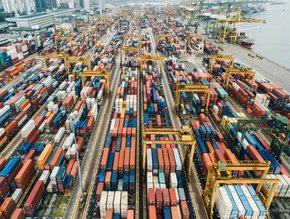Key Insights from ASCM and KPMG Supply Chain Stability Index

The Association for Supply Chain Management (ASCM) and KPMG have unveiled the latest Supply Chain Stability Index, designed to help supply chain professionals understand the stability of US operations and act as a barometer for the global supply chain community.
How the Supply Chain Stability Index works
KPMG's latest report states that four factors are considered in the Supply Chain Stability Index:
- The overall volume of goods shipped
- The speed at which goods reach their destination
- The cost of transporting goods from the source to the ultimate destination
- The variability of these factors

The Current State of the Global Supply Chain
The index says 2023 saw "tremendous improvement and increased supply chain stability overall, with several variables still driving continued fragility".
However, suggestions of nearing a return to pre-pandemic normality over the next 12 months are largely dismissed, with factors such as cross-border patrol closures between US and Mexico trade corridors – as well as conflict in the Middle East leading to attacks on commercial ships in the Red Sea – highlighted as adding to recent instability.
However, there remain reasons to be positive, such as greater nearshoring efforts in Mexico and Canada, reducing reliance on other regions.
"While supply chain challenges do persist, the overall return to increased levels of stability is a testament to the incredible efforts of countless supply chain professionals,” comments Abe Eshkenazi, CEO at ASCM.
“The index continues to confirm that people make all the difference. We must continue cultivating supply chain talent to mitigate disruptions, build resiliency and drive growth.”
Jim Lee, Supply Chain AI Leader at KPMG, adds: “Even though the Supply Chain Stability Index shows a reduction in operations instability throughout the year, there are still challenges such as cross-border patrol closures and conflicts leading to commercial ship attacks.
"While a complete return to pre-pandemic normality in 2024 is unlikely, there are positive developments such as the comeback of just-in-time inventory strategies and a slight easing of competition for talent in the labour market. However, the logistics sector still faces significant challenges due to geopolitical factors and volume fluctuations. It is important for supply chains to remain vigilant and adopt resilient strategies for continued progress.”
How companies can improve
In their index, ASCM and KPMG also highlight some key themes for companies to be aware of, including:
- Inventory optimisation: Inventory levels, inflated during the pandemic, are now strategically decreasing throughout the supply chain, indicating a shift toward optimised inventory management. Purposeful efforts across all nodes in the supply chain are leading to improvements in inventory.
- Automation and the future of labour: The competition for talent, notably for entry-level roles across the entire supply chain, persists, albeit with a slight alleviation from previous intensity. Lower unemployment rates and increased automation adoption are key factors contributing to this evolving trend.
- Ongoing logistics challenges: Geopolitical tensions persist, disrupting the global movement of goods, notably impacting ocean freight, especially between Asia and the EU and, to a lesser degree, the US. These factors underscore ongoing residual risks within the sector.
Douglas Kent, Executive Vice President of Strategy and Alliances at ASCM, says: "As we navigate the complexities of modern supply chains, having actionable insights is paramount. This index helps shed light on risks that remain as well as areas of progression. For example, we’re now seeing just-in-time inventory strategies making a comeback and the competitive talent market beginning to ease, thanks to the effective use of technology.
“We must continue to leverage data to monitor and adapt to the complex and ever-evolving supply chain landscape.”
Earlier this year, we spoke to Chris McCarney, Principal, Procurement & Outsourcing Advisory Leader at KPMG.
******
Make sure you check out the latest edition of Procurement Magazine and also sign up to our global conference series - Procurement & Supply Chain LIVE 2024
******
Procurement Magazine is a BizClik brand






